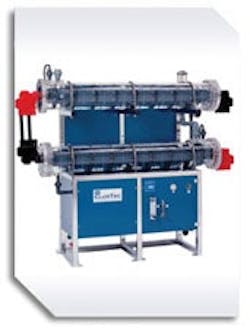Conversion from Gas to Liquid Disinfection Yields Improved Water Quality, Cost Savings
| Related Searches from WaterInfoLink.com Disinfection | Partnership for Safe Water | Sodium Hypochlorite Generation System | Severn Trent Services | W.R. Wise Water Treatment Plant |
In 2006, the Greenwood, S.C., Commissioners of Public Works became only the fourth U.S. water utility ever to receive Phase IV Excellence in Water Treatment recognition from the Partnership for Safe Water . Phase IV is the highest possible level of performance that can be achieved in the Partnership program and signifies optimized plant performance.
That same year, the utility demonstrated its commitment to water quality by approving installation of a new water disinfection system at its W.R. Wise Water Treatment Plant. The system noticeably improved water quality, dramatically reduced total trihalomethanes and haloacetic acids levels, improved chloramine levels in the distribution system and produced operational cost savings, among other benefits. An onsite sodium hypochlorite generation system, known for its inherent safety when compared to the use of gaseous chlorine disinfection, was a key component of the new system.
Vulnerability assessment recommendations in 2002 had driven the Wise Plant system conversion. The utility wanted to develop a flexible alternative disinfection strategy that would enable the facility to further ensure operator and community safety, reduce hazmat and PPE training and meet U.S. Environmental Protection Agency regulations concerning disinfection byproducts (DBPs)—regulations that no longer allowed the use of free chlorine as the primary disinfectant.
The Wise Plant investigated several alternative disinfection options and ultimately, a 1,500 lb/day ClorTec on-site sodium hypochlorite generation system from Severn Trent Services was selected.
The plant also converted from gaseous anhydrous ammonia to commercial aqua ammonia (19%) and from gaseous chlorine and solid sodium chlorite to liquid sodium chlorate and 78% sulfuric acid for onsite generation of chlorine dioxide.
The onsite hypochlorite generation system selected by the Wise Plant operates by feeding softened water into a brine dissolver. The salt dissolves to form a brine solution, which is further diluted to the desired concentration. The brine solution is then passed through electrolytic cell(s), and a rectifier supplies a low-voltage DC current to the brine to produce the sodium hypochlorite. The sodium hypochlorite is then stored in three bulk storage tanks. When it reaches the low-level set point, the system automatically restarts to replenish its supply. Three liquid feeders inject the hypochlorite as needed.
In addition to significant improvements in water quality, the use of onsite sodium hypochlorite generation offers several other advantages For example, these systems do not suppress finished water pH to the extent that gaseous chlorine disinfection does. Therefore, the amount of pH adjustment chemical (e.g., lime or caustic) necessary before distribution of finished water is reduced.
The onsite generation process is a cost-effective disinfection alternative. A pound of chlorine equivalent can be generated on site using salt, water and electricity for as low as 25 cents/lb of chlorine equivalent (2008 pricing). Systems typically provide a return on initial investment within three to five years.
Improved Water Quality
Once the new disinfection system was online at the Wise Plant, there was a noticeable improvement in water quality, including a dramatic reduction in total trihalomethanes and haloacetic acids levels, improvement of chloramine levels in the distribution system, a reduction in flushing required at dead ends and savings through the reduced need for post-pH adjustment chemicals.
Annual flushing has been reduced by 76% and the flushing process takes less time, equating to a cost savings of $12,688/year. Post-pH adjustment with lime or caustic has resulted in a reduction of 30 lb per million gal per day, a savings of $11,436/year.
The Wise Plant used chlorine dioxide as the primary disinfectant, which was key to reducing DBPs prior to coagulation. The 0.8% sodium hypochlorite and chloramines used before and after filtration, respectively, provided more stability in maintaining the chloramine residuals in the distribution system with no additional production of DBPs.
The conversion from gas to liquid disinfection at the Wise Plant has proven to be extremely cost-effective. The onsite sodium hypochlorite generation system provides water that is free of pathogens, reducing acute risks; eliminates the production of DBPs, dramatically reducing chronic risks; and maintains a residual disinfectant in the distribution system for continued pathogen deactivation.
